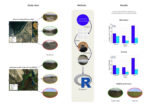Abundance and habitat preferences of house mouse Mus musculus in the desert of northern Peru
Luiggi Carrasco-Escudero, Olinda Burga Hurtado, Zoila Vega Guarderas, Álvaro García-Olaechea, Natalí HurtadoThe house mouse is a commensal species that invades natural ecosystems and threatens both native rodents and ecosystems. Therefore, it is important to describe the population of Mus musculus in native ecosystems to develop effective management plans for eradicating or controlling this species. In this study, we assessed the abundance and habitat preferences of M. musculus in Reserva Nacional de Illescas (RNI) and Manglares de San Pedro de Vice (MSPV) using capture-recapture methods during 2021 and 2022. We recorded only a few captures (N = 3) of M. musculus in the RNI, whereas numerous captures and recaptures (N = 195 and N = 41, respectively) were recorded at the MSPV. Our analysis suggests that M. musculus prefers complex habitats. We discuss the implications of the presence of house mice in mangrove ecosystems and emphasize the population dynamics of this species for its control and management in legally protected areas. In conclusion, the population size of the house mouse varies among different habitats, with a preference for complex environments.
Abundancia y preferencias de hábitat del ratón doméstico Mus musculus en el desierto del norte del Perú. El ratón doméstico es una especie comensal que invade ecosistemas naturales y amenaza tanto a las especies nativas de roedores como a los ecosistemas. Por lo tanto, es importante describir la población de Mus musculus en ecosistemas nativos para diseñar planes de manejo efectivos con el objetivo de erradicar o controlar esta especie. En este estudio, evaluamos la abundancia y las preferencias de hábitat de M. musculus en la Reserva Nacional de Illescas (RNI) y en los Manglares de San Pedro de Vice (MSPV), usando métodos de captura-recaptura durante 2021 y 2022. Registramos algunas capturas de M. musculus en la RNI y numerosas capturas y recapturas de esta especie en los MSPV, y estimamos que M. musculus prefiere hábitats más complejos. Discutimos las consecuencias de la presencia del ratón doméstico en los manglares y resaltamos los aspectos poblacionales de esta especie para su control y manejo en áreas de conservación. Concluimos que el ratón doméstico varía el tamaño población entre los diferentes hábitats y muestra preferencia por hábitats complejos.
